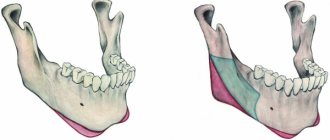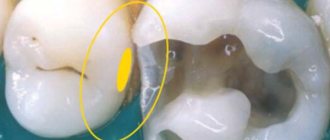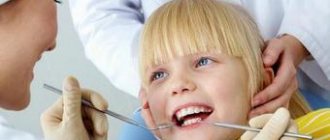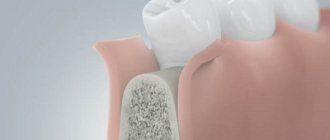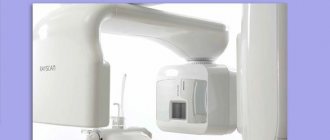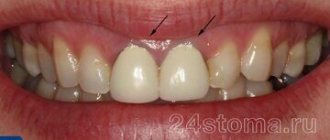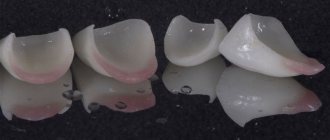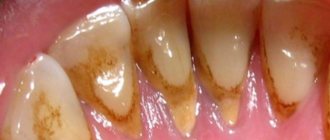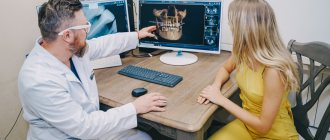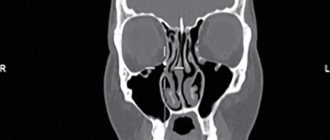4138
It is still believed that the best implants for bone surgery are autogenous (taken from the patient himself) bone. However, due to its limited nature and pronounced resorption, this material still cannot be considered ideal.
A good alternative is bone substitutes obtained from animal bones. The Bio Oss biomaterial produced by Geistlich Pharma, intended for use in dentistry, contains all the main advantages of bone substitutes.
General overview
Bio Oss is obtained from cattle bones. The material has several dosage forms, allowing you to choose the optimal method of delivery to the surgical wound:
- Granules packaged in bottles (Bio-Oss Spongiosa). Universal form, suitable for any type of operation.
- Granules in a syringe (Bio-Oss Pen). Thanks to the specially shaped tip, Bio-Oss Pen is especially convenient in cases where the operating area is in a hard-to-reach place.
- Blocks (Bio-Oss Block). Used when filling significant defects is required.
- Combined preparation Bio-Oss Collagen, 90% consisting of Bio-Oss granules, 10% porcine collagen. Thanks to the latter, it has increased adhesive, manipulation and regenerative properties.
Geistlich Pharma also produces Geistlich Bio-Gide Membrane, an auxiliary material used to create a barrier between the bone and the sinus. The use of Bio-Gide accelerates tissue regeneration and wound healing.
Geistlich Bio-Oss is recommended for use in all types of bone grafting - in dental surgery, implantology, periodontology, and maxillofacial surgery.
In terms of its regenerating and healing properties, it is not only comparable to autogenous bone grafts, but in individual components it is superior to them.
Besides:
- Bio-Oss can be used alone or in combination with autogenous bone.
- Bone substitute effectively stabilizes the blood clot, preventing alveolar bleeding.
- High hydrophilicity, caused by the presence of many micro- and macropores, promotes uniform and rapid impregnation of the material with saline solution and the patient’s blood.
- Stability and preservation of the volume of the resulting bone tissue is a winning point from the point of view of ensuring the aesthetics of facial tissue.
- The multiplicity of forms and good handling characteristics make it possible to use Bio-Oss in a wide variety of clinical cases, including complex ones.
The technique for using Bio-Oss depends on the clinical situation and the dosage form used. The following points are common:
- Soaking the material with saline solution or the patient’s blood.
- It is supplied to the operation area and distributed over the defect.
- Closure of the surgical wound with a flap of the patient's soft tissue, followed by suturing and/or application of a Bio-Gide membrane.
Let’s find out together how long the temperature lasts after dental implantation, and in what cases the help of specialists is needed.
Come here if you are interested in the benefits of dental implants.
At this address https://www.vash-dentist.ru/implantatsiya/metodiki/o-prieme-antibiotikov-posle-zubov.html we will tell you why antibiotics are prescribed after dental implantation.
Comparison of Collagen and Block cytotoxicity
As a result of medical research, it was revealed that Bio-Oss collagen has mild cytotoxic properties. This is another important point, since the cytotoxic mechanism is aimed at destroying foreign agents: protozoan microorganisms, viruses and bacteria. In this regard, the drug is not recommended for use in patients with infectious diseases. These include damage to the body by viruses, bacteria, helminths and protozoan microorganisms. If you suffer from acute viral illnesses, tell your doctor.
If bone replacement material must be placed urgently, an alternative option, Bio-Oss Pen, can be used. Before injecting the product into the bone, the patient should consult a specialist and undergo a full medical examination. This will help avoid possible side effects and serious consequences.
Indications and contraindications
In orthopedics, Bio Oss is recommended for use in all cases where it is necessary to maintain or increase the volume of the bone of the alveolar process or jaw:
- Filling the hole after tooth extraction to maintain the normal volume of bone tissue if implantation is planned in the future.
- Bone augmentation , performed simultaneously with tooth implantation to fill the gaps between the bone and the implant.
- Filling fenestrations and dehiscences (discrepancies and holes) in the bone after implant placement.
- Sinus lift.
- Filling cavities in the bone tissue of the jaw or alveoli formed as a result of cystectomy.
Due to the affinity of Bio Oss with human bone tissue, the biomaterial has virtually no contraindications. The only limitation is that it cannot be used to fill infected wounds.
General concepts
Bio Oss material is made from bovine bone tissue. The drug is available in several dosage forms to choose the optimal route of administration:
1. Granules placed in bottles (Spongiosa).
2. Granules placed in an injector (Pen). The special shape of the tip allows you to introduce material into hard-to-reach points.
3. Blocks. For filling large cavities.
4. Combination of granules and pork collagen (Collagen) in a ratio of 9:1. Collagen adds adhesive and regenerative characteristics to the drug.
The company also produces an auxiliary membrane, Geistlich Bio-Gide, which creates a barrier between the bone and the sinus. It promotes tissue regeneration and rapid wound healing.
Physico-chemical characteristics
Animal bones consist of 25% organic matter (collagen), 65% inorganic matter (calcium phosphate) and 10% water.
Organic matter other than collagen is present in small quantities - lipids, polysaccharides, proteins. In addition to calcium, there are ions of some other elements.
During the production of Bio-Oss, the organic component is removed from raw materials (cattle bones). All that remains is the mineral base (calcium phosphate), abundantly permeated with microcapillaries and microtunnels.
In its morphology, chemical composition and ultrastructure, Bio-Oss is very close to human bone, which determines the patient’s body’s positive reaction to it. Compared to other natural materials that have larger crystals, Bio-Oss integrates very well with native bone .
The topography of their surface is important for implanted biomaterials. Smooth materials integrate less well than rough ones. Bio-Oss has a pronounced rough surface , which promotes active adhesion and proliferation of osteoblasts and rapid matrix synthesis.
The area of the internal surfaces of the implant material is no less important. The larger it is, the more intensely the blood vessels grow into it, the more active and faster the integration and healing of wounds takes place. Histomorphometric studies carried out on 12 samples of bone materials showed that the internal surface of Geistlich Bio-Oss is about 80 m2/g, which is approximately 5 times greater than that of the other samples studied.
When is it necessary and when is it not? And, if necessary, then how?
Socket augmentation during immediate implantation is not required as often as is commonly believed. Consequently, we do not need biomaterials in every clinical case.
I will give simple examples.
In these clinical situations, it is critical to preserve the shape and linear dimensions of the alveolar ridge as much as possible. Let's consider two options for the state of the socket after removal of the central incisor.
Option 1.
The tooth is removed due to the destruction of the crown part and the impossibility of further restoration. The periapical inflammatory process, if present, is weakly expressed.
Option 2.
The tooth is removed due to a periapical inflammatory process, accompanied by active exudation and the formation of a fistulous tract.
In your opinion, in which case are the risks of loss of the vestibular wall of the socket (and, consequently, atrophy and loss of aesthetic result) the highest?
Of course, in the second option. With this type of inflammatory process, tissue lysis occurs and, as a result, the vestibular wall of the socket disappears quite quickly, and therefore requires support. In the first option, the condition of the bone tissue and mucous membrane is such, and the development of the inflammatory process itself is restrained by the body, so the risks of loss of the linear dimensions of the alveolar ridge are minimal. Therefore, you can achieve a satisfactory result even without socket augmentation (in the photo on the right - a temporary crown, installed the next day after implantation):
In the second option the situation is somewhat more complicated.
After the removal of a tooth and the accompanying granuloma, a large hole remains with a thin vestibular wall damaged by the inflammatory process:
First of all, you need to decide on preparing the hole for the implant. You can check the correct positioning of the socket using analogue implants included in the XiVE Dentsply Implants kit:
Let me remind you that with the correct positioning of the implant in the area of the anterior teeth, it is adjacent to the palatal wall of the socket, and its axis extends to the palatal surface of the future crown. As a last resort, on the cutting edge.
The implant is always smaller in volume than the tooth itself:
Therefore, we have the question of filling the “empty” space between the vestibular wall of the socket and the surface of the implant. And, oddly enough, with Bio-Oss Collagen it is more convenient to do this before installing the implant.
The graft is adapted (using a scalpel) and placed in the desired position. To do this, again, it is very convenient to use analogues of implants from the implantology set (as a last resort, osteotomes or parallel pins):
Let me remind you that there is no need to fill the entire hole with graft. Moreover, the cavity of a removed cyst or granuloma. Therefore, 100 mg is enough to augment a hole of any size.
Thanks to its properties. Bio-Oss Collagen does not clog into the prepared implant socket, does not move or slide during installation:
That's all, actually. Further, our biomaterial behaves exactly the same as regular Bio-Oss - it quickly becomes saturated with blood and is perfectly held in place:
In this case, we planned to complete the stage with the immediate installation of a temporary crown; the orthopedist will do this half an hour after installing the implant. In the meantime, I close the implant with a gum former and apply sutures:
Thus, the issue of augmentation during immediate implantation is decided based on the state of the vestibular wall of the socket; the use of biomaterials is justified in cases where there is a risk of its lysis. A similar decision is made in the area of the lateral group of teeth. Unless the aesthetic factor is taken into account here, to a greater extent, based on the wishes of the patient.
Here's the situation:
For a number of reasons, we are forced to remove the top six and replace it with an implant.
It all starts with tooth extraction:
Pay attention to the condition of the vestibular wall of the socket. In the projection of the root tips, you can see a bone defect caused by a long-term inflammatory process (in fact, why this tooth had to be removed). In this case, the vestibular wall of the socket inevitably lyses after tooth extraction, and this will not only lead to problems in aesthetics, but will also complicate subsequent care of the prosthetic structure. Therefore, in this case, we must consider, among other things, the augmentation of the socket. And the procedure here is slightly different than in the previous case.
The Astratech implant (Dentsply Implants) is installed:
For augmentation we also use Bio-Oss Collagen 100 mg, cut it to size using a scalpel and position it in the sockets of the buccal roots:
We place the former on the implant and suture the socket. Let me remind you that any biomaterial must be hermetically sealed in the wound (success factor III). Otherwise, it does more harm than good:
There is no need to tighten the edges of the wound at all (if we used regular Bio-Oss, this would be necessary). Another difference between Bio-Oss Collagen is that it does not blur when bleeding.
After a week, the stitches can be removed. The wound area looks like this:
And two months later - like this:
At this stage, to create a more correct gingival contour, you can change the former to a larger size:
And after another month - install a temporary crown:
In this case, could we do without socket augmentation? Well, they could. But in this case, the tissues surrounding the crown would look different, and the patient himself would experience problems with care - due to the loss of volume, he would constantly have food debris stuck between the crown and the gum.
Safety
Biomaterial obtained from cattle bones may contain prions, special infectious agents that can cause dangerous diseases in animals and humans. The first have “mad cow disease” (TSE, spongiform encephalopathy).
People are at risk of getting Creutzfeldt-Jakob syndrome, kuru and some other types of infections.
The safety of the Bio Oss biomaterial is ensured by two factors - the high quality of raw materials and processing technology, which involves multi-stage cleaning and sterilization.
When choosing raw materials, the country of origin is taken into account in terms of the effectiveness of veterinary control and precautionary measures taken against “mad cow disease”.
Geistlich Pharma purchases bone raw materials for Bio-Oss in the USA, where veterinary control is very effective. So far, not a single case of spongiform encephalopathy has been recorded.
To further guarantee safety, raw materials are obtained only from 3 slaughterhouses under constant USDA supervision.
The second factor ensuring the safety of the material is the multi-stage purification of raw materials aimed at inactivating prions. The bones are exposed to temperature for at least 15 hours.
Additionally, chemical purification of raw materials with alkaline compounds and treatment with gamma irradiation are carried out. This technology guarantees the complete safety of the biomaterial.
Characteristics of Bio Oss
The composition of animal bones is 25% collagen, 65% calcium phosphate, 10% water. Lipids, proteins and polysaccharides are present in small quantities. There are ions of calcium and other elements.
During the manufacturing process of a medicine, organic elements are removed from raw materials. Only the mineral base, penetrated by a capillary network, is left.
The chemical composition, structure and morphology of Bio Oss are almost identical to human bone. This determines the body’s positive reaction to the introduction of the composition. The material integrates perfectly with the native bone.
The bone substitute is distinguished by a pronounced rough surface that promotes active adhesion, proliferation of osteoblasts and accelerated matrix synthesis.
The internal surface of Bio-Oss reaches 80 m2/g. Due to this, intensive ingrowth of blood vessels into the implantation material and accelerated integration are observed.
Safety
Biomaterial made from cattle bones may contain prions - infectious agents that can provoke dangerous diseases: Creutzfeldt-Jakob syndrome, kuru and other types of infection.
The safety of Bio-Oss is ensured by high-quality raw materials and strict adherence to processing technologies. Raw materials undergo multi-stage cleaning and sterilization. The material is exposed to temperature for 15 hours and undergoes chemical cleaning.
When choosing raw materials, manufacturers take into account the country of origin. The effectiveness of veterinary control and precautionary measures aimed at combating the spread of “mad cow disease” are taken into account.
Geistlich Pharma purchases bone raw materials in the USA, where strict veterinary controls are in place. To date, no cases of spongiform encephalopathy have been recorded.
For added safety, raw materials are collected only from three USDA-monitored slaughterhouses.
Biological properties
There are three groups of osteoplastic materials:
- osteoinductive - affect bone formation and growth;
- osteoconductive - act as a frame on which new bone tissue is formed;
- osteoneutral - bone filler.
Bio Oss is part of the group of oteoconductive materials. The osteoconductive properties of the biomaterial are due to the large internal surface area, increased protein absorption and integrin activity.
The microstructure of the composition is distinguished by its extensive internal space. Thanks to this, Bio Oss is an ideal scaffold for newly formed bone tissue.
Result of application
Numerous histological studies revealed that already 5 days after surgery, osteoblasts created mature collagen fibers on Bio-Oss. After six weeks, the formation of an extensive matrix network was observed.
Due to slow resorption, the biomaterial forms a reliable framework for regenerating tissue. It has been proven that implant material made from a combination of native bone and substitute demonstrates high stability.
The adhesion strength of Bio Oss implants in the sinuses after sinus lift three months after surgery is 45% higher than that of implants made from autogenous bone tissue.
Biological properties
Osteoplastic materials are divided into three groups:
- osteoinductive , directly affecting the formation and growth of bone tissue;
- osteoconductive - play the role of a bone frame on which new bone tissue is formed;
- osteoneutral , acting as a bone filler.
Bio Oss belongs to osteoconductive biomaterials, i.e. it functions as a scaffold on which new bone tissue is formed and differentiated.
The high osteoconductive properties of the material are determined by the large internal surface area, high absorption of proteins and the activity of heterodimeric proteins (integrins), which ensure cell adhesion to the matrix.
The microstructure is characterized by the presence of large free internal space. This makes the material an optimal scaffold for newly formed bone tissue.
After the operation, rapid and deep growth of blood vessels into the implanted material occurs, trophism is activated, and osteoblasts, young bone tissue cells involved in matrix synthesis, actively migrate from the patient’s tissues to the defect area. Further, during the regeneration process, osteoblasts are transformed into osteocytes - mature bone tissue.
On what day are sutures removed after dental implantation and the reasons for their separation.
This article provides detailed information about anterior dental implants.
Here https://www.vash-dentist.ru/implantatsiya/metodiki/o-sdache-analizov-pered-zubov.html read what tests you need to take before dental implantation.
What properties of biomaterials are really important for practice?
As an example, let’s take grafts – the most well-known and frequently used biomaterials in implantology practice.
You need to know the following about them:
- Depending on the source of origin (natural or synthetic), all grafts from all companies are manufactured in approximately the same way . There is a difference in the technological nuances of production, this explains the differences in physical and biological properties.
- All grafts, regardless of their source of origin, have one task - to maintain a given volume for the time necessary for bone tissue regeneration.
- There are no “magic” grafts that themselves turn into bone tissue. They do not contain any cellular elements, growth factors, or any nutrients that accelerate bone tissue regeneration. The presence of organic substances in the graft is currently the subject of debate - some say that it is bad, others believe that there is nothing wrong with it. The truth, as usual, is somewhere in the middle.
Consequently, stories that “this graft turns into bone tissue better than others” can only be spread by theorists and amateurs. The patterns and physiological mechanisms of bone tissue regeneration are common to all clinical cases and do not depend on the type of grafts used. Finally come to terms with it.
If everything I wrote above is true, then the questions arise:
What graft properties are really important for practice? And which of its features can be overlooked?
The answer is very simple:
- only what you can touch, check, measure and understand, without any rumors, speculation and custom-made “scientific” articles.
This is, first of all:
- form factor , that is, in the form of what substance the material is produced. We know that grafts come in different forms: in the form of large fragments (blocks, rings or even entire sections of jaws), powders, liquid or semi-liquid substances (gels, suspensions, mastics, etc.). The graft can be in a regular jar, syringe or special applicator.
- physical properties : hydrophilicity, aggregability, surface area, etc.
- biological properties : ability to integrate, antigenic purity, resorption rate, etc.
You can learn more about these properties and how important they are by attending RegenerationDay , a special seminar dedicated to biomaterials and their use in implantology.
Expected effect of application
The high integration of Bio-Oss with native bone tissue has been established by numerous histological studies. It was noted that already 15 days after surgery, osteoblasts formed mature collagen fibers on Bio-Oss.
It took about 6 weeks to form an extensive matrix network - collagen fibers woven into the biomaterial frame. Histological sections revealed organic substances that regenerated independently inside the implantation tissue or got there from the patient’s blood.
Thanks to its slow resorption, Bio-Oss serves as a stable scaffold for regenerating tissue and slows down the resorption of the graft. Studies have found that implantation material made from a mixture of substitute and native bone is more stable than implants in which autogenous bone chips are used as the only component.
In the case of the use of Bio-Oss, constancy of bone volume was noted throughout the observation , while the use of one autogenous material was accompanied by a decrease in the volume of implant material.
Histomorphometric analysis of tissues subjected to restoration using Bio-Oss showed that the volume of the mineral component in the regenerated bone is higher than in native bone tissue.
This may explain the high stability of implants containing Bio-Oss in combination with autogenous bone.
The adhesion strength of implants in the sinuses after sinus lift was also studied. It was found that 3 months after surgery, materials with Bio-Oss had 45% greater fixation strength than implants made from autogenous bone.
The video provides instructions on how to use the material.
Recommendations
- Jung RE et al., Postextraction tissue management: the soft tissue punch method, Int J Periodontics Restorative Dent 2004; 24 (6): 545-553
- Araujo MG et al., Dynamics Geistlich Bio-Oss Collagen® incorporating fresh wounds for extraction: a pilot study in a dog, Clin Oral Implants Res 2010; 21(1):55-64
- Nevins ML et al., Three-dimensional microcomputed tomographic assessment of periodontal regeneration: a report of intravascular defects processed by BOC, Int J Periodontics Restorative Dent 2005; 25 (4): 365-373
- Nevins ML et al., Evaluation of renal rheology after intrazonal defect grafting with Bio-Oss Collagen®: a human histological report, Int J Periodontics Restorative Dent 2003; 23(1):9-17
- Araujo MG, Linder E et al., Bio-Oss Collagen® in the buccal cleft for direct implants: a 6-month study in a dog, Clin Oral Implants Res 2011; 22(1):1-8
- Heinemann F, Hasan I et al., Bone level modification in extraction sockets with Bio-Oss Collagen® and implant placement: a clinical study, Ann Anat 2012; 194(6):508-12
Documented: Over 1000 publications Reliable: Over 29 years of clinical experience Verified: 163 years Geistlich collagen competence
Prospects
Today, bone transplantation mainly uses autogenous materials and PRP (platelet-rich plasma). The latter is a gel containing blood plasma and platelets, which play a major role in tissue regeneration and healing.
Apparently, the time is not far when surgeons will have autogenous biomaterials grown outside the body at their disposal.
However, for any implantation materials, regardless of their origin, a carrier is required that ensures effective tissue regeneration and meets a number of requirements, including:
- high cell adhesion;
- saving space;
- positive effect on bone morphology;
- support cell differentiation.
And from this point of view, bone substitutes like Bio-Oss, capable of working together with PRP, can be considered as very promising materials.
Benefits of Bio-Oss
The product is safe for the human body. This material has many advantages:
- High hydrophilic properties. Penetrating into the body, the drug is quickly absorbed by the blood. Such properties are possible due to the pores located on the surface of the granules.
- Product compatibility with human bone. The granules reach the newly formed bone and connect with it, forming a strong and reliable frame. This helps speed up the process of tissue repair without harm to the body.
- Low rate of resorption. Unlike other products of this type, Bio-Oss disintegrates slowly, due to which it has a long-lasting effect on the bone, promoting its regeneration.
- Safety. The product is a biofunctional material and can therefore be used to treat a wide range of musculoskeletal diseases.
The Bio-Oss material can be used alone or in combination with another osteoplastic element—autologous bone. The bone replacement material is implanted into natural tissue within 3 months. The product can be purchased at a price of no less than 6,000 rubles.
conclusions
The use of natural biomaterials in maxillofacial surgery is becoming increasingly popular. Their developed internal surface has a positive effect on the adhesion and differentiation of cells in the defect area.
Low resorbability increases volume stability. The natural structure of the carriers, close to human ones, creates favorable conditions for the regeneration of new bones. All this promises materials like Bio-Oss to be in high demand in surgery.
If you find an error, please select a piece of text and press Ctrl+Enter.
Tags bone materials
Did you like the article? stay tuned
Previous article
Root canal obturation – prolonging the life and full functions of the tooth
Next article
When is the use of the Persin apparatus for the correction of malocclusions justified?
Why does atrophy occur?
Jawbone atrophy occurs as a result of prolonged absence of teeth, and, as a result, a decrease in the load on the bone from the tooth roots. Less commonly, due to inflammatory processes or jaw injury.
To a greater extent, atrophy prevents dental implantation, but together with missing teeth, the problem also brings a lot of trouble to the patient:
- the contours of the face are distorted, the lips fall inside the mouth, a large number of wrinkles appear,
- it is impossible to fully chew food, which can cause diseases of the gastrointestinal tract,
- incorrect facial expressions, articulation, speech disorders,
- violation of the integrity of the dentition, displacement, loosening or complete loss of teeth.
That is why teeth need to be replaced and bone tissue needs to be restored.
Jaw bone structure
However, not every part of the jaw bone undergoes atrophic processes. Consider the structure of the fabric:
- spongy or alveolar bone,
- basal plate-base,
- cortical bone.
Spongy bone is the central section of bone tissue where the roots of living teeth are located. It consists of a small number of bone septa, as well as a large number of capillaries. It is she who is more susceptible to atrophy in the absence of teeth, because the cells are nourished through the blood vessels2.
The other two sections - the basal base and the cortical bone (this is a kind of shell) - are more durable, since they consist mainly of bone partitions. They do not shrink or atrophy and are sterile compared to the spongy part.
There is also a zygomatic bone, located in the area of the chewing teeth behind the basal section (that is, even deeper), as well as buttresses or force lines of the skull (peculiar bone thickenings). They do not undergo atrophic processes, therefore they are used to attach some models of dental implants.
